Albert
Einstein (14 March 1879 – 18 April 1955) was a German-born
theoretical physicist who developed the general theory of
relativity, one of the two pillars of modern physics (alongside
quantum mechanics). While best known for his mass–energy
equivalence formula E = mc2 (which has been dubbed "the
world's most famous equation"), he received the
1921 Nobel Prize in Physics "for his services to theoretical
physics, and especially for his discovery of the law of
the photoelectric effect". The latter was pivotal in
establishing quantum theory.
Near
the beginning of his career, Einstein thought that Newtonian
mechanics was no longer enough to reconcile the laws of
classical mechanics with the laws of the electromagnetic
field. This led to the development of his special theory
of relativity. He realized, however, that the principle
of relativity could also be extended to gravitational
fields, and with his subsequent theory of gravitation
in 1916, he published a paper on the general theory of
relativity. He continued to deal with problems of statistical
mechanics and quantum theory, which led to his explanations
of particle theory and the motion of molecules. He also
investigated the thermal properties of light which laid
the foundation of the photon theory of light. In 1917,
Einstein applied the general theory of relativity to model
the large-scale structure of the universe.
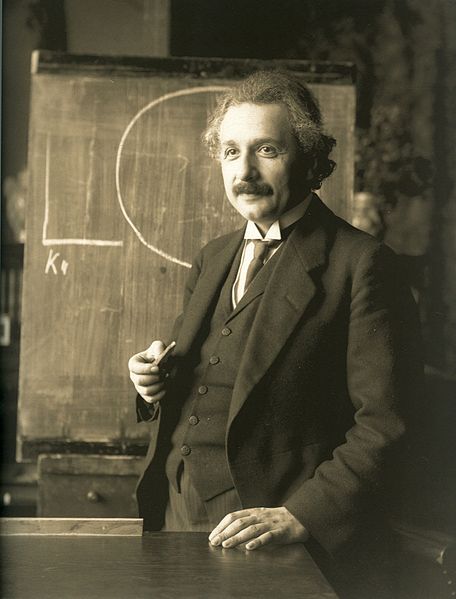
Albert Einstein in 1921
He
was visiting the United States when Adolf Hitler came
to power in 1933 and did not go back to Germany, where
he had been a professor at the Berlin Academy of Sciences.
He settled in the U.S., becoming an American citizen in
1940. On the eve of World War II, he endorsed a letter
to President Franklin D. Roosevelt alerting him to the
potential development of "extremely powerful bombs
of a new type" and recommending that the U.S.
begin similar research. This eventually led to what would
become the Manhattan Project. Einstein supported defending
the Allied forces, but largely denounced using the new
discovery of nuclear fission as a weapon. Later, with
the British philosopher Bertrand Russell, Einstein signed
the Russell–Einstein Manifesto, which highlighted
the danger of nuclear weapons. Einstein was affiliated
with the Institute for Advanced Study in Princeton, New
Jersey, until his death in 1955.
Einstein
published more than 300 scientific papers along with over
150 non-scientific works. His great intellectual achievements
and originality have made the word "Einstein"
synonymous with genius.
Biography
Early
life and education
Albert
Einstein was born in Ulm, in the Kingdom of Württemberg
in the German Empire on 14 March 1879. His father was
Hermann Einstein, a salesman and engineer. His mother
was Pauline Einstein (née Koch). In 1880, the family
moved to Munich, where his father and his uncle founded
Elektrotechnische Fabrik J. Einstein & Cie, a company
that manufactured electrical equipment based on direct
current.
.jpg)
Einstein at the age of three in 1882
The
Einsteins were non-observant Jews. Albert attended a Catholic
elementary school from the age of five for three years.
At the age of eight, he was transferred to the Luitpold
Gymnasium (now known as the Albert Einstein Gymnasium)
where he received advanced primary and secondary school
education until he left Germany seven years later. Contrary
to popular suggestions that he had struggled with early
speech difficulties, the Albert Einstein Archives indicate
he excelled at the first school that he attended. He was
right-handed; there appears to be no evidence for the
widespread popular belief that he was left-handed.
His
father once showed him a pocket compass; Einstein realized
that there must be something causing the needle to move,
despite the apparent "empty space". As
he grew, Einstein built models and mechanical devices
for fun and began to show a talent for mathematics.[10]
When Einstein was ten years old, Max Talmud (later changed
to Max Talmey), a poor Jewish medical student from Poland,
was introduced to the Einstein family by his brother.
During weekly visits over the next five years, he gave
the boy popular books on science, mathematical texts and
philosophical writings. These included Immanuel Kant's
Critique of Pure Reason, and Euclid's Elements (which
Einstein called the "holy little geometry book").
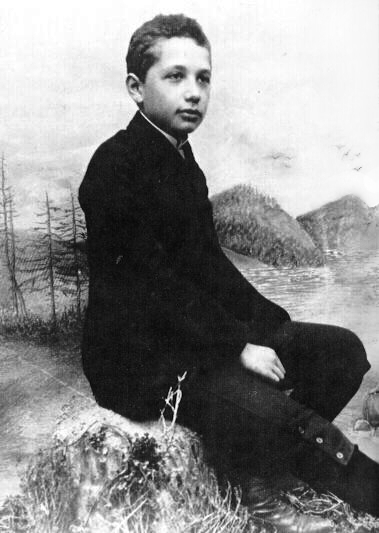
Albert Einstein in 1893 (age 14)
In
1894, his father's company failed: direct current (DC)
lost the War of Currents to alternating current (AC).
In search of business, the Einstein family moved to Italy,
first to Milan and then, a few months later, to Pavia.
When the family moved to Pavia, Einstein stayed in Munich
to finish his studies at the Luitpold Gymnasium. His father
intended for him to pursue electrical engineering, but
Einstein clashed with authorities and resented the school's
regimen and teaching method. He later wrote that the spirit
of learning and creative thought were lost in strict rote
learning. At the end of December 1894, he travelled to
Italy to join his family in Pavia, convincing the school
to let him go by using a doctor's note. It was during
his time in Italy that he wrote a short essay with the
title "On the Investigation of the State of the
Ether in a Magnetic Field."
In
1895, at the age of sixteen, Einstein sat the entrance
examinations for the Swiss Federal Polytechnic in Zurich
(later the Eidgenössische Technische Hochschule ETH).
He failed to reach the required standard in the general
part of the examination, but obtained exceptional grades
in physics and mathematics. On the advice of the Principal
of the Polytechnic, he attended the Aargau Cantonal School
in Aarau, Switzerland, in 1895–96 to complete his
secondary schooling. While lodging with the family of
Professor Jost Winteler, he fell in love with Winteler's
daughter, Marie. (Albert's sister Maja later married Wintelers'
son Paul.) In January 1896, with his father's approval,
he renounced his citizenship in the German Kingdom of
Württemberg to avoid military service. In September
1896, he passed the Swiss Matura with mostly good grades,
including a top grade of 6 in physics and mathematical
subjects, on a scale of 1-6, and, though only seventeen,
enrolled in the four-year mathematics and physics teaching
diploma program at the Zurich Polytechnic. Marie Winteler
moved to Olsberg, Switzerland for a teaching post.
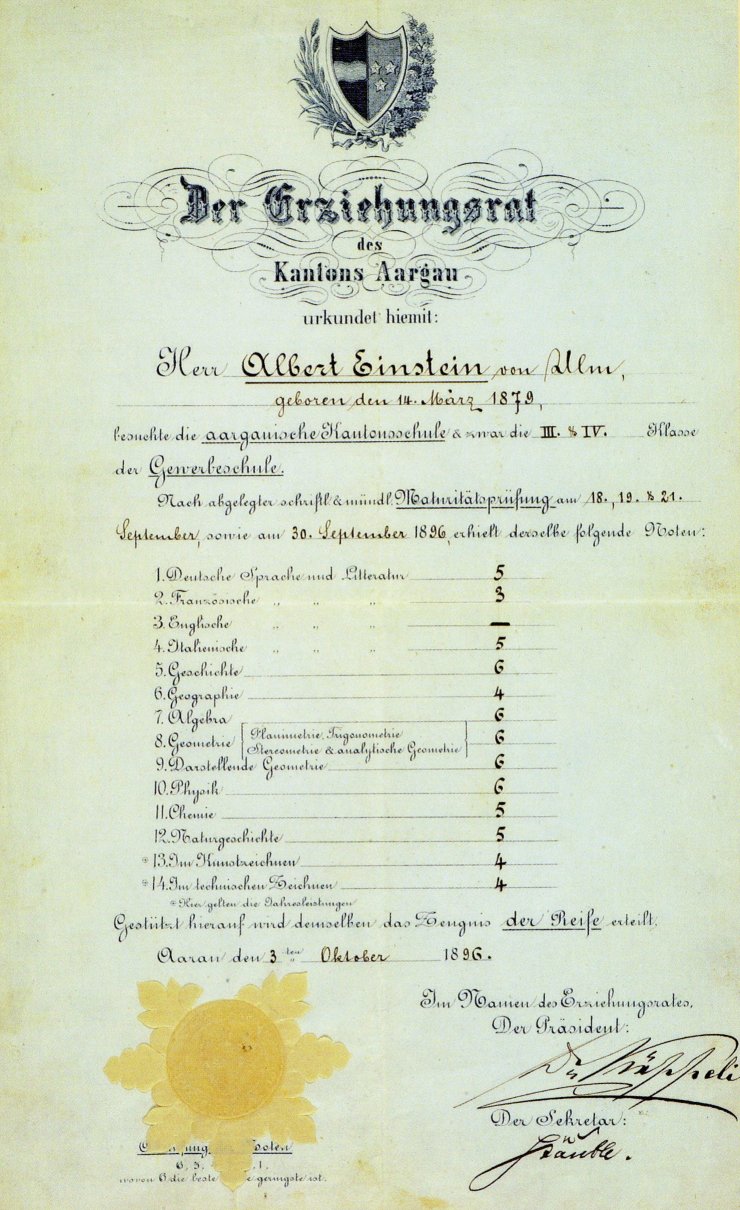
Einstein's matriculation certificate at the age of 17,
showing his final grades from the Aargau Kantonsschule
(on a scale of 1-6, with 6 being the best mark).
Einstein's
future wife, Mileva Maric', also enrolled at the Polytechnic
that same year, the only woman among the six students
in the mathematics and physics section of the teaching
diploma course. Over the next few years, Einstein and
Maric''s friendship developed into romance, and they read
books together on extra-curricular physics in which Einstein
was taking an increasing interest. In 1900, Einstein was
awarded the Zurich Polytechnic teaching diploma, but Maric'
failed the examination with a poor grade in the mathematics
component, theory of functions. There have been claims
that Maric' collaborated with Einstein on his celebrated
1905 papers, but historians of physics who have studied
the issue find no evidence that she made any substantive
contributions.
Marriages
and children
With
the discovery and publication in 1987 of an early correspondence
between Einstein and Maric' it became known that they
had a daughter they called "Lieserl" in their
letters, born in early 1902 in Novi Sad where Maric' was
staying with her parents. Maric' returned to Switzerland
without the child, whose real name and fate are unknown.
Einstein probably never saw his daughter, and the contents
of a letter he wrote to Maric' in September 1903 suggest
that she was either adopted or died of scarlet fever in
infancy.
Einstein
and Maric' married in January 1903. In May 1904, the couple's
first son, Hans Albert Einstein, was born in Bern, Switzerland.
Their second son, Eduard, was born in Zurich in July 1910.
In 1914, Einstein moved to Berlin, while his wife remained
in Zurich with their sons. They divorced on 14 February
1919, having lived apart for five years.
Einstein
married Elsa Löwenthal on 2 June 1919, after having
had a relationship with her since 1912. She was his first
cousin maternally and his second cousin paternally. In
1933, they emigrated to the United States. In 1935, Elsa
Einstein was diagnosed with heart and kidney problems
and died in December 1936.
Patent
office
After
graduating, Einstein spent almost two frustrating years
searching for a teaching post. He acquired Swiss citizenship
in February 1901, but was not conscripted for medical
reasons. With the help of Marcel Grossmann's father Einstein
secured a job in Bern at the Federal Office for Intellectual
Property, the patent office, as an assistant examiner.
He evaluated patent applications for electromagnetic devices.
In 1903, Einstein's position at the Swiss Patent Office
became permanent, although he was passed over for promotion
until he "fully mastered machine technology".
Much
of his work at the patent office related to questions
about transmission of electric signals and electrical-mechanical
synchronization of time, two technical problems that show
up conspicuously in the thought experiments that eventually
led Einstein to his radical conclusions about the nature
of light and the fundamental connection between space
and time.
With
a few friends he met in Bern, Einstein started a small
discussion group, self-mockingly named "The Olympia
Academy", which met regularly to discuss science
and philosophy. Their readings included the works of Henri
Poincaré, Ernst Mach, and David Hume, which influenced
his scientific and philosophical outlook.
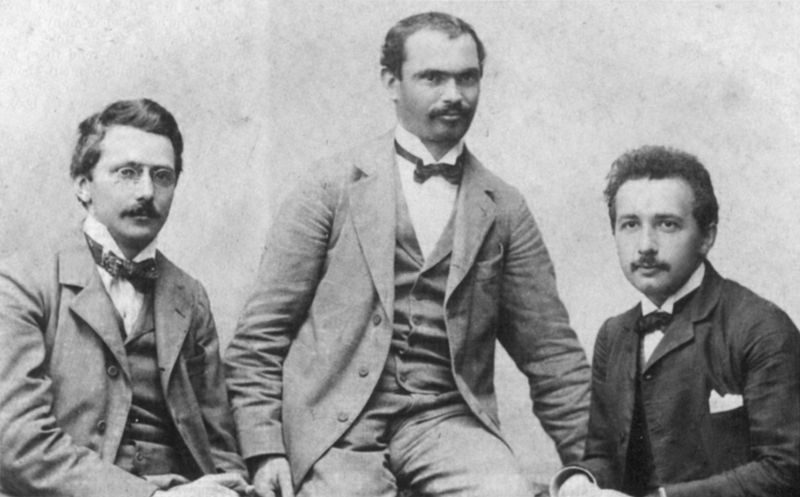
Left
to right: Conrad Habicht, Maurice Solovine and
Einstein, who founded the Olympia Academy
Academic
career
In
1901, his paper "Folgerungen aus den Capillaritätserscheinungen"
("Conclusions from the Capillarity Phenomena")
was published in the prestigious Annalen der Physik. On
30 April 1905, Einstein completed his thesis, with Alfred
Kleiner, Professor of Experimental Physics, serving as
pro-forma advisor. Einstein was awarded a PhD by the University
of Zurich. His dissertation was entitled "A New
Determination of Molecular Dimensions." This
paper included Einstein's initial estimates of Avagadro
constant as 2.2×1023 based on diffusion coefficients
and viscosities of sugar solutions in water. That same
year, which has been called Einstein's annus mirabilis
(miracle year), he published four groundbreaking papers,
on the photoelectric effect, Brownian motion, special
relativity, and the equivalence of mass and energy, which
were to bring him to the notice of the academic world.
By
1908, he was recognized as a leading scientist, and he
was appointed lecturer at the University of Bern. The
following year, he quit the patent office and the lectureship
to take the position of physics docent at the University
of Zurich. He became a full professor at Charles-Ferdinand
University in Prague in 1911. Also in 1911, corrections
of algebraic errors in his thesis brought Einstein's Avogadro
constant estimate to 6.6×1023. In 1914, he returned
to Germany after being appointed director of the Kaiser
Wilhelm Institute for Physics (1914–1932) and a professor
at the Humboldt University of Berlin, with a special clause
in his contract that freed him from most teaching obligations.
He became a member of the Prussian Academy of Sciences.
In 1916, Einstein was appointed president of the German
Physical Society (1916–1918).
During
1911, he had calculated that, based on his new theory
of general relativity, light from another star would be
bent by the Sun's gravity. That prediction was claimed
confirmed by observations made by a British expedition
led by Sir Arthur Eddington during the solar eclipse of
29 May 1919. International media reports of this made
Einstein world famous. On 7 November 1919, the leading
British newspaper The Times printed a banner headline
that read: "Revolution in Science – New Theory
of the Universe – Newtonian Ideas Overthrown".
Much later, questions were raised whether the measurements
had been accurate enough to support Einstein's theory.
In 1980 historians John Earman and Clark Glymour published
an analysis suggesting that Eddington had suppressed unfavorable
results. The two reviewers found possible flaws in Eddington's
selection of data, but their doubts, although widely quoted
and, indeed, now with a "mythical" status almost
equivalent to the status of the original observations,
have not been confirmed. Eddington's selection from the
data seems valid and his team indeed made astronomical
measurements verifying the theory.
In
1921, Einstein was awarded the Nobel Prize in Physics
for his explanation of the photoelectric effect, as relativity
was considered still somewhat controversial. He also received
the Copley Medal from the Royal Society in 1925.
.jpg)
Einstein's official 1921 portrait after
receiving the Nobel Prize in Physics.
Travels
abroad
Einstein
visited New York City for the first time on 2 April 1921,
where he received an official welcome by Mayor John Francis
Hylan, followed by three weeks of lectures and receptions.
He went on to deliver several lectures at Columbia University
and Princeton University, and in Washington he accompanied
representatives of the National Academy of Science on
a visit to the White House. On his return to Europe he
was the guest of the British statesman and philosopher
Viscount Haldane in London, where he met several renowned
scientific, intellectual and political figures, and delivered
a lecture at King's College.
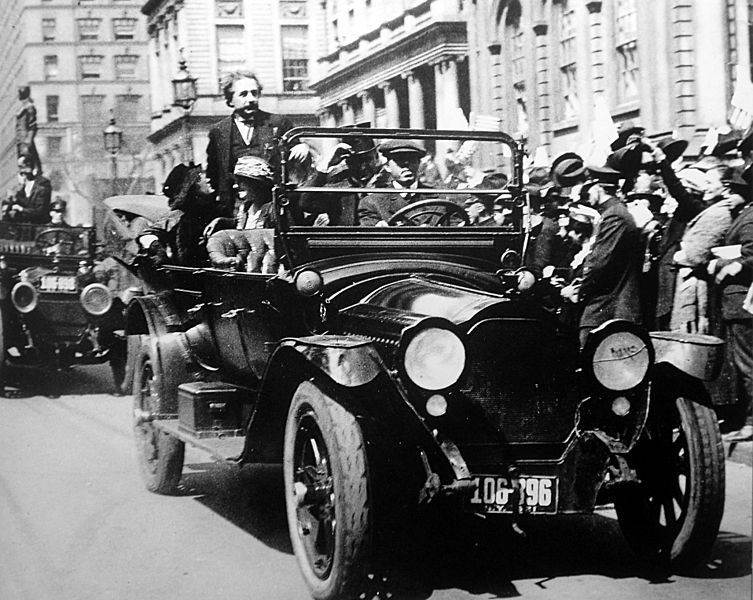
Einstein in New York, 1921, his first visit to the United
States
In
1922, he traveled throughout Asia and later to Palestine,
as part of a six-month excursion and speaking tour. His
travels included Singapore, Ceylon, and Japan, where he
gave a series of lectures to thousands of Japanese. His
first lecture in Tokyo lasted four hours, after which
he met the emperor and empress at the Imperial Palace
where thousands came to watch. Einstein later gave his
impressions of the Japanese in a letter to his sons: "Of
all the people I have met, I like the Japanese most, as
they are modest, intelligent, considerate, and have a
feel for art."
On
his return voyage, he also visited Palestine for 12 days
in what would become his only visit to that region. "He
was greeted with great British pomp, as if he were a head
of state rather than a theoretical physicist", writes
Isaacson. This included a cannon salute upon his arrival
at the residence of the British high commissioner, Sir
Herbert Samuel. During one reception given to him, the
building was "stormed by throngs who wanted to hear
him". In Einstein's talk to the audience, he expressed
his happiness over the event:
"I consider this the greatest day of my life. Before,
I have always found something to regret in the Jewish
soul, and that is the forgetfulness of its own people.
Today, I have been made happy by the sight of the Jewish
people learning to recognize themselves and to make themselves
recognized as a force in the world."
Emigration
to U.S. in 1933
In
February 1933 while on a visit to the United States, Einstein
decided not to return to Germany due to the rise to power
of the Nazis under Germany's new chancellor, Adolf Hitler.
He visited American universities in early 1933 where he
undertook his third two-month visiting professorship at
the California Institute of Technology in Pasadena. He
and his wife Elsa returned by ship to Belgium at the end
of March. During the voyage they were informed that their
cottage was raided by the Nazis and his personal sailboat
had been confiscated. Upon landing in Antwerp on 28 March,
he immediately went to the German consulate where he turned
in his passport and formally renounced his German citizenship.
A few years later, the Nazis sold his boat and turned
his cottage into an Aryan youth camp.
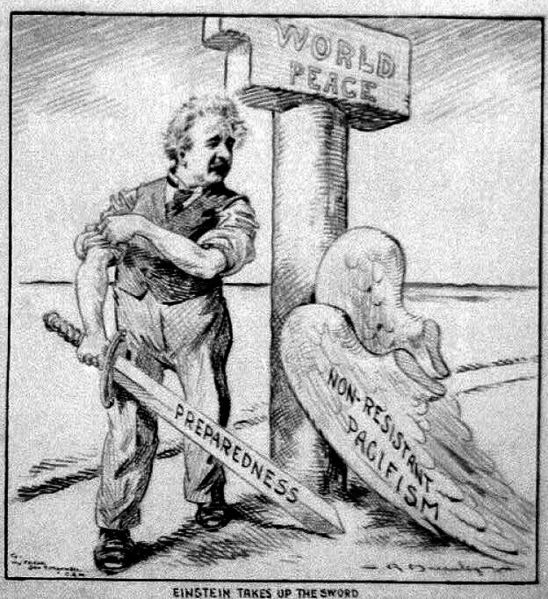
Cartoon
of Einstein, who has shed his "Pacifism" wings,
standing
next to a pillar labeled "World Peace." He is
rolling up his sleeves
and holding a sword labeled "Preparedness" (circa
1933).
In
early April 1933, he learned that the new German government
had passed laws barring Jews from holding any official
positions, including teaching at universities. A month
later, Einstein's works were among those targeted by Nazi
book burnings, and Nazi propaganda minister Joseph Goebbels
proclaimed, "Jewish intellectualism is dead."
Einstein also learned that his name was on a list of assassination
targets, with a "$5,000 bounty on his head."
One German magazine included him in a list of enemies
of the German regime with the phrase, "not yet hanged".
He
resided in Belgium for some months, before temporarily
living in England. In a letter to his friend, physicist
Max Born, who also emigrated from Germany and lived in
England, Einstein wrote, "... I must confess that
the degree of their brutality and cowardice came as something
of a surprise."
In
October 1933 he returned to the U.S. and took up a position
at the Institute for Advanced Study (in Princeton, New
Jersey), that required his presence for six months each
year.[64][65] He was still undecided on his future (he
had offers from European universities, including Oxford),
but in 1935 he arrived at the decision to remain permanently
in the United States and apply for citizenship.
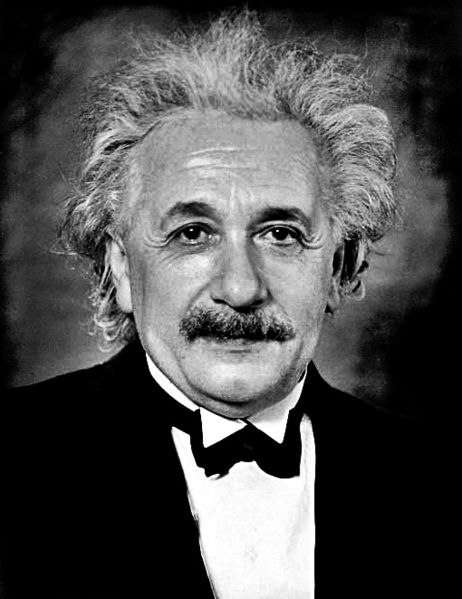
Portrait
taken in 1935 in Princeton
His
affiliation with the Institute for Advanced Study would
last until his death in 1955. He was one of the four first
selected (two of the others being John von Neumann and
Kurt Gödel) at the new Institute, where he soon developed
a close friendship with Gödel. The two would take
long walks together discussing their work. His last assistant
was Bruria Kaufman, who later became a physicist. During
this period, Einstein tried to develop a unified field
theory and to refute the accepted interpretation of quantum
physics, both unsuccessfully.
Other
scientists also fled to America. Among them were Nobel
laureates and professors of theoretical physics. With
so many other Jewish scientists now forced by circumstances
to live in America, often working side by side, Einstein
wrote to a friend, "For me the most beautiful
thing is to be in contact with a few fine Jews—a
few millennia of a civilized past do mean something after
all." In another letter he writes, "In
my whole life, I have never felt so Jewish as now."
World
War II and the Manhattan Project
In
1939, a group of Hungarian scientists that included emigre
physicist Leó Szilárd attempted to alert
Washington of ongoing Nazi atomic bomb research. The group's
warnings were discounted. Einstein and Szilárd,
along with other refugees such as Edward Teller and Eugene
Wigner, "regarded it as their responsibility to
alert Americans to the possibility that German scientists
might win the race to build an atomic bomb, and to warn
that Hitler would be more than willing to resort to such
a weapon." In the summer of 1939, a few months
before the beginning of World War II in Europe, Einstein
was persuaded to lend his prestige by writing a letter
with Szilárd to President Franklin D. Roosevelt
to alert him of the possibility. The letter also recommended
that the U.S. government pay attention to and become directly
involved in uranium research and associated chain reaction
research.
The
letter is believed to be "arguably the key stimulus
for the U.S. adoption of serious investigations into nuclear
weapons on the eve of the U.S. entry into World War II".
President Roosevelt could not take the risk of allowing
Hitler to possess atomic bombs first. As a result of Einstein's
letter and his meetings with Roosevelt, the U.S. entered
the "race" to develop the bomb, drawing on its
"immense material, financial, and scientific resources"
to initiate the Manhattan Project. It became the only
country to successfully develop an atomic bomb during
World War II.
For
Einstein, "war was a disease ... [and] he called
for resistance to war." By signing the letter
to Roosevelt, he went against his pacifist principles.
In 1954, a year before his death, Einstein said to his
old friend, Linus Pauling, "I made one great mistake
in my life — when I signed the letter to President
Roosevelt recommending that atom bombs be made; but there
was some justification — the danger that the Germans
would make them ..."
US
citizenship

Einstein accepting U.S. citizenship certificate from judge
Phillip Forman
Einstein
became an American citizen in 1940. Not long after settling
into his career at the Institute for Advanced Study (in
Princeton, New Jersey), he expressed his appreciation
of the "meritocracy" in American culture
when compared to Europe. According to Isaacson, he recognized
the "right of individuals to say and think what
they pleased", without social barriers, and as
result, the individual was "encouraged" to be
more creative, a trait he valued from his own early education.
Einstein writes:
"What makes the new arrival devoted to this country
is the democratic trait among the people. No one humbles
himself before another person or class ... American youth
has the good fortune not to have its outlook troubled
by outworn traditions."
As
a member of the National Association for the Advancement
of Colored People (NAACP) in Princeton who campaigned
for the civil rights of African Americans, Einstein corresponded
with civil rights activist W. E. B. Du Bois, and in 1946
Einstein called racism America's "worst disease".
He later stated, "Race prejudice has unfortunately
become an American tradition which is uncritically handed
down from one generation to the next. The only remedies
are enlightenment and education".
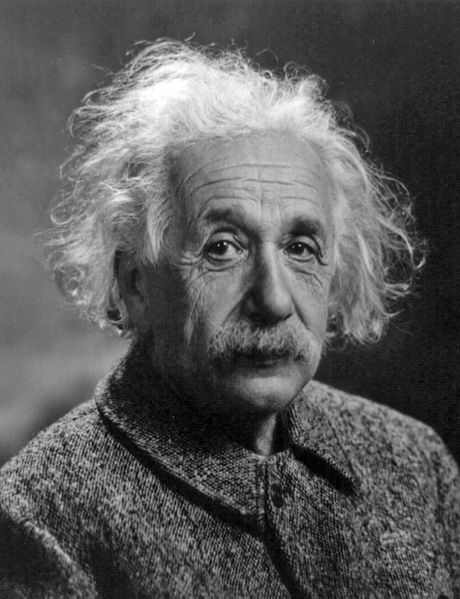
Einstein in 1947
During
the final stage of his life, Einstein transitioned to
a vegetarian lifestyle, arguing that "the vegetarian
manner of living by its purely physical effect on the
human temperament would most beneficially influence the
lot of mankind".
After
the death of Israel's first president, Chaim Weizmann,
in November 1952, Prime Minister David Ben-Gurion offered
Einstein the position of President of Israel, a mostly
ceremonial post. The offer was presented by Israel's ambassador
in Washington, Abba Eban, who explained that the offer
"embodies the deepest respect which the Jewish
people can repose in any of its sons". However,
Einstein declined, and wrote in his response that he was
"deeply moved", and "at once
saddened and ashamed" that he could not accept
it:
"All my life I have dealt with objective matters,
hence I lack both the natural aptitude and the experience
to deal properly with people and to exercise official
function. I am the more distressed over these circumstances
because my relationship with the Jewish people became
my strongest human tie once I achieved complete clarity
about our precarious position among the nations of the
world."
Death
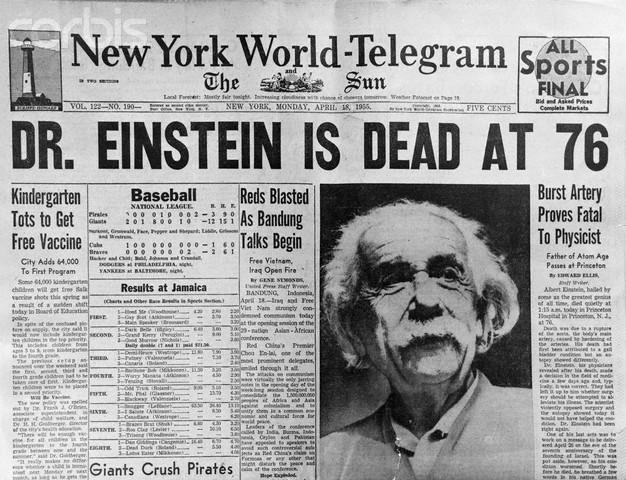
On
17 April 1955, Albert Einstein experienced internal bleeding
caused by the rupture of an abdominal aortic aneurysm,
which had previously been reinforced surgically by Dr.
Rudolph Nissen in 1948. He took the draft of a speech
he was preparing for a television appearance commemorating
the State of Israel's seventh anniversary with him to
the hospital, but he did not live long enough to complete
it.
Einstein
refused surgery, saying: "I want to go when I
want. It is tasteless to prolong life artificially. I
have done my share, it is time to go. I will do it elegantly."
He died in Princeton Hospital early the next morning at
the age of 76, having continued to work until near the
end.
During
the autopsy, the pathologist of Princeton Hospital, Thomas
Stoltz Harvey, removed Einstein's brain for preservation
without the permission of his family, in the hope that
the neuroscience of the future would be able to discover
what made Einstein so intelligent. Einstein's remains
were cremated and his ashes were scattered at an undisclosed
location.
In
his lecture at Einstein's memorial, nuclear physicist
Robert Oppenheimer summarized his impression of him as
a person: "He was almost wholly without sophistication
and wholly without worldliness ... There was always with
him a wonderful purity at once childlike and profoundly
stubborn."
Albert
Einstein and Fying Saucers
Only
once is it known for certain that Albert Einstein spoke
directly about UFOs. In the St. Louis Post Dispatch, AP
Item, 7/30/52, it is reported that Einstein wrote evangelist
Louis Gardner (in reply to Gardner’s query about
UFOs).
"These
people have seen something - What it is I do not know
and am not curious to know".
- Albert Einstein, Institute for Advanced Study, Princeton,
New Jersey (reply letter to Californian Minister, July
23rd, 1952)

Einstein-Oppenheimer
Draft
This
six-page document titled, "Relationships With
Inhabitants of Celestial Bodies", is the first
document to use the phrase Extraterrestrial Biological
Entities, or EBEs. It says the presence of unidentified
spacecraft is accepted as de facto by the military - and
this is dated June 1947.
It
deals with the subjects that you would expect competent
scientists to deal with - i.e., where do they come from,
what does the law say about it, what should we do in the
event of colonization and/or integration of peoples, and
why are they here?
The
document suggests that in the event that EBE's desire
to settle here on earth there will be "profound change
in traditional concepts" of law and the possible
need for a new "Law Among Planetary Peoples."
There
is also propositions concerning the necessary creation
of a "Cosmic International law" that would protect
the rights of all celestial states to lay claim on otherwise
unclaimed solar territories.
Finally,
the document addresses the presence of celestial astroplanes
in our atmosphere as a result of actions of military experiments
with fission and fusion devices of warfare.
The
authors of this document encourage consideration of our
potential future situation and safety due to our present
and past actions in space.
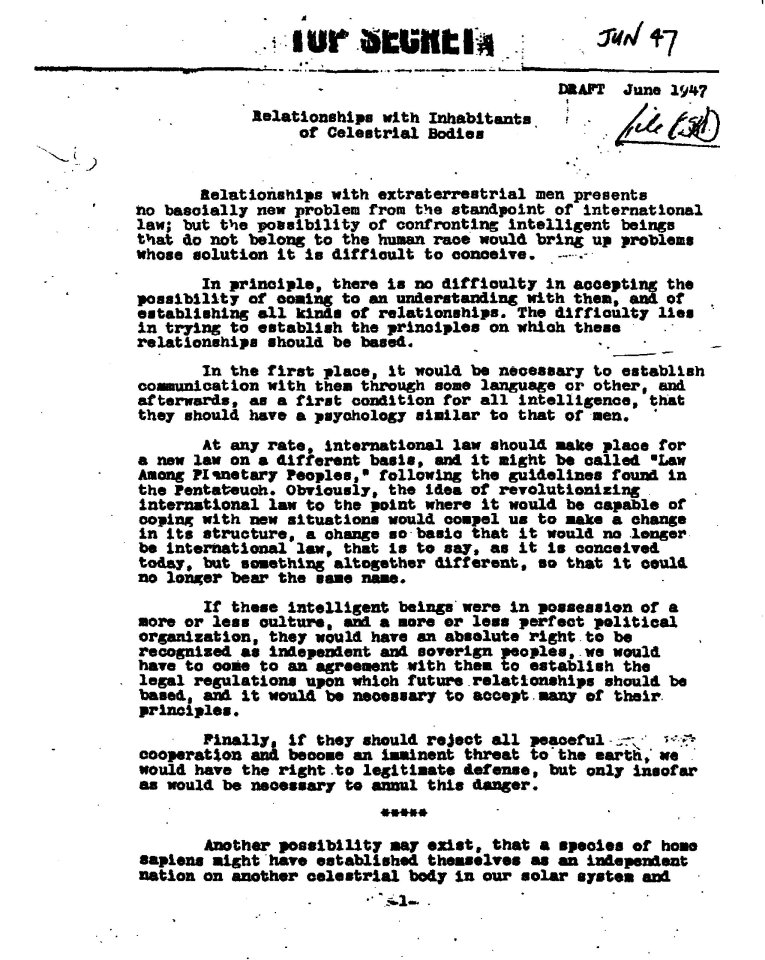
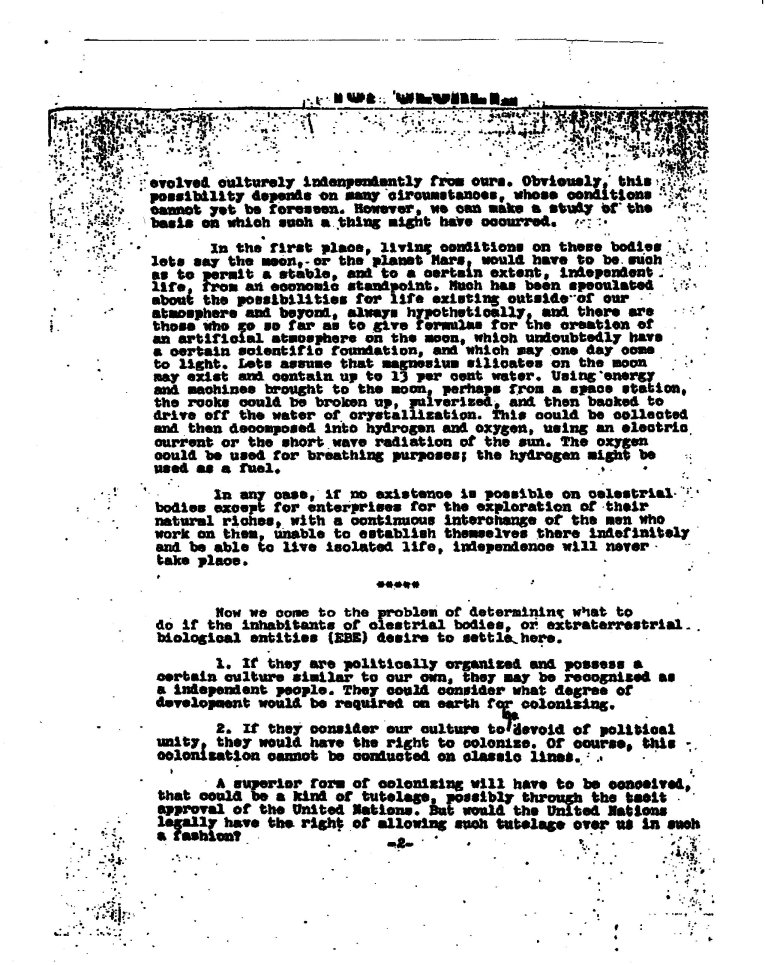
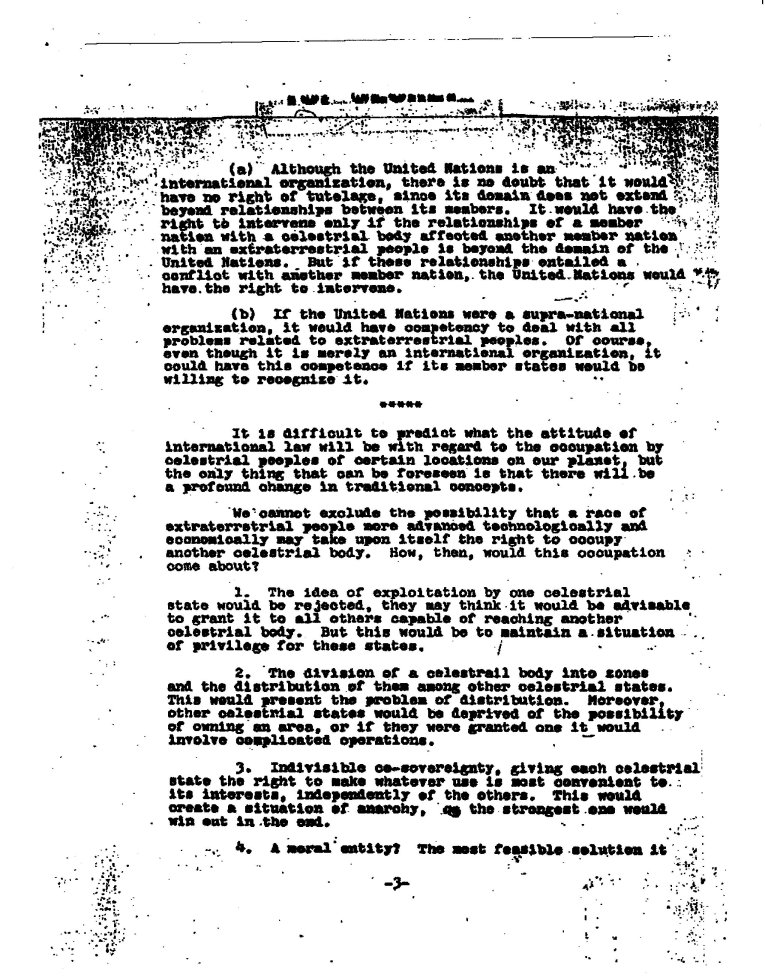

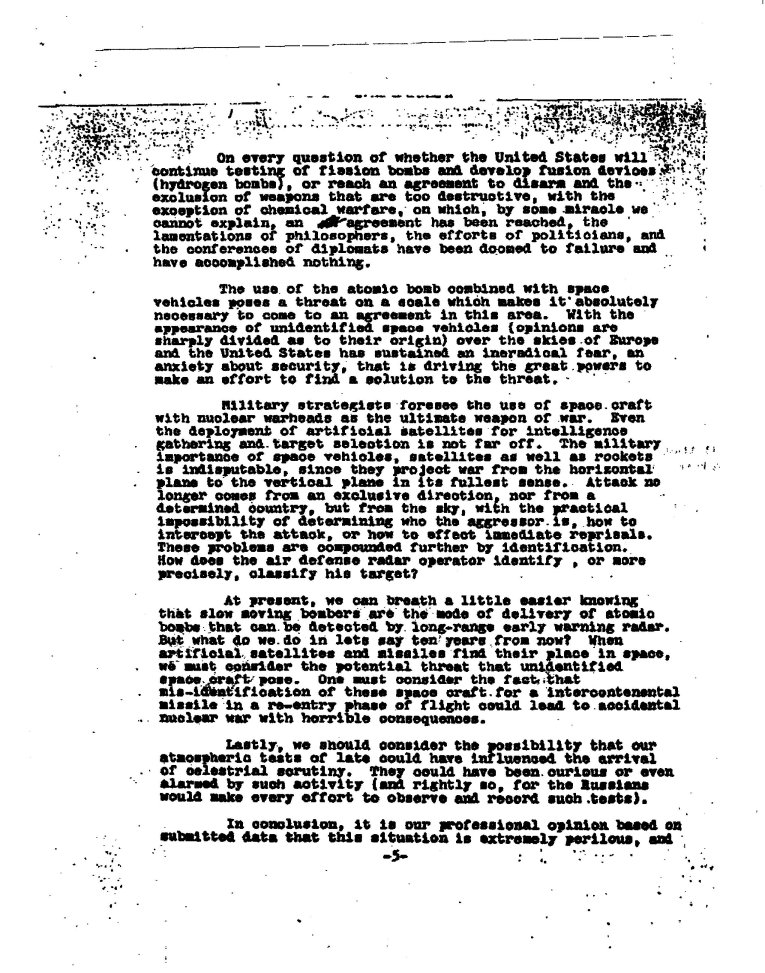
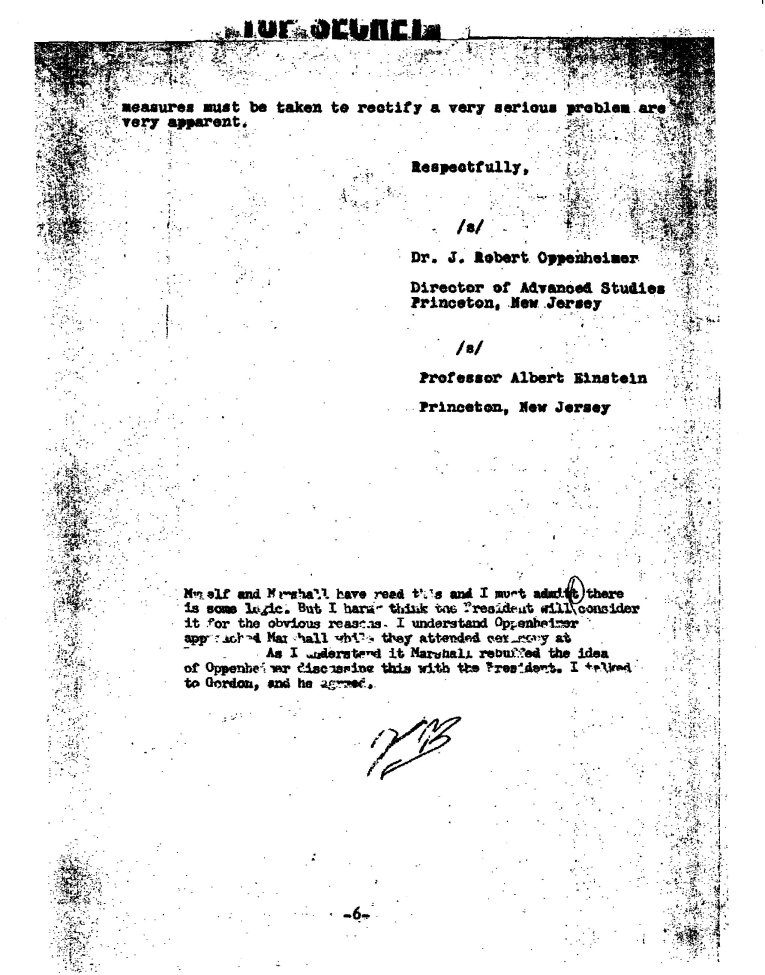
Sources:
http://en.wikipedia.org/wiki/Albert_Einstein
http://www.abovetopsecret.com/forum/thread922593/pg1
http://www.bibliotecapleyades.net/sociopolitica/esp_sociopol_mj12_3p.htm
